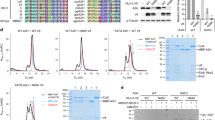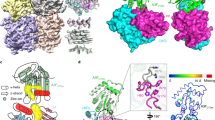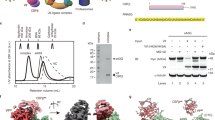Abstract
Apolipoprotein B mRNA-editing enzyme catalytic polypeptide–like 3G (APOBEC3G, referred to here as A3G) is a potent antiretroviral host factor against human immunodeficiency virus type 1 (HIV-1). HIV-1 viral infectivity factor (Vif) counteracts A3G by promoting its degradation via the ubiquitin-proteasome pathway. Recent studies demonstrated that protein kinase A (PKA) phosphorylates activation-induced deaminase (AID), another member of the APOBEC3 family. A3G has two putative PKA phosphorylation residues. Here we show that PKA binds and specifically phosphorylates A3G at Thr32 in vitro and in vivo. This phosphorylation event reduces the binding of A3G to Vif and its subsequent ubiquitination and degradation, and thus promotes A3G antiviral activity. Computer-assisted structural modeling and mutagenesis studies suggest that the interaction between A3G Thr32 and Arg24 is crucial for interaction with Vif. These data imply that PKA-mediated phosphorylation of A3G can regulate the interaction between A3G and Vif.
This is a preview of subscription content, access via your institution
Access options
Subscribe to this journal
Receive 12 print issues and online access
$189.00 per year
only $15.75 per issue
Buy this article
- Purchase on Springer Link
- Instant access to full article PDF
Prices may be subject to local taxes which are calculated during checkout





Similar content being viewed by others
References
Harris, R.S. et al. DNA deamination mediates innate immunity to retroviral infection. Cell 113, 803–809 (2003).
Mangeat, B. et al. Broad antiretroviral defence by human APOBEC3G through lethal editing of nascent reverse transcripts. Nature 424, 99–103 (2003).
Zhang, H. et al. The cytidine deaminase CEM15 induces hypermutation in newly synthesized HIV-1 DNA. Nature 424, 94–98 (2003).
Shindo, K. et al. The enzymatic activity of CEM15/Apobec-3G is essential for the regulation of the infectivity of HIV-1 virion but not a sole determinant of its antiviral activity. J. Biol. Chem. 278, 44412–44416 (2003).
Sheehy, A.M., Gaddis, N.C., Choi, J.D. & Malim, M.H. Isolation of a human gene that inhibits HIV-1 infection and is suppressed by the viral Vif protein. Nature 418, 646–650 (2002).
Kobayashi, M., Takaori-Kondo, A., Miyauchi, Y., Iwai, K. & Uchiyama, T. Ubiquitination of APOBEC3G by an HIV-1 Vif-Cullin5-Elongin B-Elongin C complex is essential for Vif function. J. Biol. Chem. 280, 18573–18578 (2005).
Shirakawa, K. et al. Ubiquitination of APOBEC3 proteins by the Vif-Cullin5-ElonginB-ElonginC complex. Virology 344, 263–266 (2006).
Honjo, T., Kinoshita, K. & Muramatsu, M. Molecular mechanism of class switch recombination: linkage with somatic hypermutation. Annu. Rev. Immunol. 20, 165–196 (2002).
Basu, U. et al. The AID antibody diversification enzyme is regulated by protein kinase A phosphorylation. Nature 438, 508–511 (2005).
Pasqualucci, L., Kitaura, Y., Gu, H. & Dalla-Favera, R. PKA-mediated phosphorylation regulates the function of activation-induced deaminase (AID) in B cells. Proc. Natl. Acad. Sci. USA 103, 395–400 (2006).
Shabb, J.B. Physiological substrates of cAMP-dependent protein kinase. Chem. Rev. 101, 2381–2411 (2001).
Aandahl, E.M. et al. Protein kinase A type I antagonist restores immune responses ofT cells from HIV-infected patients. FASEB J. 12, 855–862 (1998).
Cole, S.W., Jamieson, B.D. & Zack, J.A. cAMP up-regulates cell surface expression of lymphocyte CXCR4: implications for chemotaxis and HIV-1 infection. J. Immunol. 162, 1392–1400 (1999).
Hayes, M.M., Lane, B.R., King, S.R., Markovitz, D.M. & Coffey, M.J. Prostaglandin E2 inhibits replication of HIV-1 in macrophages through activation of protein kinase A. Cell. Immunol. 215, 61–71 (2002).
Thivierge, M., Le Gouill, C., Tremblay, M.J., Stankova, J. & Rola-Pleszczynski, M. Prostaglandin E2 induces resistance to human immunodeficiency virus-1 infection in monocyte-derived macrophages: downregulation of CCR5 expression by cyclic adenosine monophosphate. Blood 92, 40–45 (1998).
Rabbi, M.F., Al-Harthi, L. & Roebuck, K.A. TNFα cooperates with the protein kinase A pathway to synergistically increase HIV-1 LTR transcription via downstream TRE-like cAMP response elements. Virology 237, 422–429 (1997).
Rabbi, M.F., al-Harthi, L., Saifuddin, M. & Roebuck, K.A. The cAMP-dependent protein kinase A and protein kinase C-β pathways synergistically interact to activate HIV-1 transcription in latently infected cells of monocyte/macrophage lineage. Virology 245, 257–269 (1998).
Cartier, C. et al. Active cAMP-dependent protein kinase incorporated within highly purified HIV-1 particles is required for viral infectivity and interacts with viral capsid protein. J. Biol. Chem. 278, 35211–35219 (2003).
Li, P.L. et al. Phosphorylation of HIV Nef by cAMP-dependent protein kinase. Virology 331, 367–374 (2005).
Hofmann, B., Nishanian, P., Nguyen, T., Insixiengmay, P. & Fahey, J.L. Human immunodeficiency virus proteins induce the inhibitory cAMP/protein kinase A pathway in normal lymphocytes. Proc. Natl. Acad. Sci. USA 90, 6676–6680 (1993).
Xu, H. et al. A single amino acid substitution in human APOBEC3G antiretroviral enzyme confers resistance to HIV-1 virion infectivity factor-induced depletion. Proc. Natl. Acad. Sci. USA 101, 5652–5657 (2004).
Mangeat, B., Turelli, P., Liao, S. & Trono, D. A single amino acid determinant governs the species-specific sensitivity of APOBEC3G to Vif action. J. Biol. Chem. 279, 14481–14483 (2004).
Bogerd, H.P., Doehle, B.P., Wiegand, H.L. & Cullen, B.R. A single amino acid difference in the host APOBEC3G protein controls the primate species specificity of HIV type 1 virion infectivity factor. Proc. Natl. Acad. Sci. USA 101, 3770–3774 (2004).
Schrofelbauer, B., Chen, D. & Landau, N.R. A single amino acid of APOBEC3G controls its species-specific interaction with virion infectivity factor (Vif). Proc. Natl. Acad. Sci. USA 101, 3927–3932 (2004).
Huthoff, H. & Malim, M.H. Identification of amino acid residues in APOBEC3G required for regulation by human immunodeficiency virus type 1 Vif and Virion encapsidation. J. Virol. 81, 3807–3815 (2007).
Chen, K.M. et al. Structure of the DNA deaminase domain of the HIV-1 restriction factor APOBEC3G. Nature 452, 116–119 (2008).
Prochnow, C., Bransteitter, R., Klein, M.G., Goodman, M.F. & Chen, X.S. The APOBEC-2 crystal structure and functional implications for the deaminase AID. Nature 445, 447–451 (2007).
Mulder, L.C., Harari, A. & Simon, V. Cytidine deamination induced HIV-1 drug resistance. Proc. Natl. Acad. Sci. USA 105, 5501–5506 (2008).
Kobayashi, M. et al. APOBEC3G targets specific virus species. J. Virol. 78, 8238–8244 (2004).
Strebel, K. et al. The HIV A (sor) gene product is essential for virus infectivity. Nature 328, 728–730 (1987).
Simon, J.H., Southerling, T.E., Peterson, J.C., Meyer, B.E. & Malim, M.H. Complementation of vif-defective human immunodeficiency virus type 1 by primate, but not nonprimate, lentivirus vif genes. J. Virol. 69, 4166–4172 (1995).
Pham, P., Bransteitter, R. & Goodman, M.F. Reward versus risk: DNA cytidine deaminases triggering immunity and disease. Biochemistry 44, 2703–2715 (2005).
Conticello, S.G., Thomas, C.J., Petersen-Mahrt, S.K. & Neuberger, M.S. Evolution of the AID/APOBEC family of polynucleotide (deoxy)cytidine deaminases. Mol. Biol. Evol. 22, 367–377 (2005).
Baker, D. & Sali, A. Protein structure prediction and structural genomics. Science 294, 93–96 (2001).
Oka, T. et al. Highly conserved configuration of catalytic amino acid residues among calicivirus-encoded proteases. J. Virol. 81, 6798–6806 (2007).
Song, H. et al. A single amino acid of the human immunodeficiency virus type 2 capsid affects its replication in the presence of cynomolgus monkey and human TRIM5αs. J. Virol. 81, 7280–7285 (2007).
Ponder, J.W. & Case, D.A. Force fields for protein simulations. Adv. Protein Chem. 66, 27–85 (2003).
Acknowledgements
We thank H. Akari (Tukuba Primate Research Center, National Institute of Biomedical Innovation) for the pNLA1-43Vif plasmid, A. Imura (Graduate School of Medicine, Kyoto University) for the anti-GFP mAb and M. Malim (King's College London School of Medicine) for providing the anti-Vif monoclonal antibody (#319) through the AIDS Research and Reference Reagent Program, Division of AIDS, National Institute of Allergy and Infectious Disease, National Institutes of Health. This study was partly supported by grants-in-aid from the Ministry of Education, Culture, Sports, Science and Technology and from the Ministry of Health, Labour and Welfare, Japan. This study was also partly supported by grants-in-aid from the Naito Foundation, from the Mitsubishi Pharma Research Foundation and from The Shimizu Foundation for the Promotion of Immunology Research.
Author information
Authors and Affiliations
Contributions
K.S. designed research, performed research, contributed vital new reagents, analyzed data and wrote the paper; A.T.-K. designed research, analyzed data, wrote the paper and organized research; M.Y. and H.S. performed the structure modeling and wrote the paper; T.I., M.M., K.I. and T.S. prepared the materials and performed a part of research; T.U. analyzed data, drafted the paper and organized research.
Corresponding author
Supplementary information
Supplementary Text and Figures
Supplementary Figures 1 and 2 (PDF 188 kb)
Rights and permissions
About this article
Cite this article
Shirakawa, K., Takaori-Kondo, A., Yokoyama, M. et al. Phosphorylation of APOBEC3G by protein kinase A regulates its interaction with HIV-1 Vif. Nat Struct Mol Biol 15, 1184–1191 (2008). https://doi.org/10.1038/nsmb.1497
Received:
Accepted:
Published:
Issue Date:
DOI: https://doi.org/10.1038/nsmb.1497
This article is cited by
-
Anoikis-related genes signature development for clear cell renal cell carcinoma prognosis and tumor microenvironment
Scientific Reports (2023)
-
Protein kinase A inhibits tumor mutator APOBEC3B through phosphorylation
Scientific Reports (2019)
-
Structural basis for targeted DNA cytosine deamination and mutagenesis by APOBEC3A and APOBEC3B
Nature Structural & Molecular Biology (2017)
-
Automethylation of protein arginine methyltransferase 6 (PRMT6) regulates its stability and its anti-HIV-1 activity
Retrovirology (2013)
-
HIV-1-associated PKA acts as a cofactor for genome reverse transcription
Retrovirology (2013)



